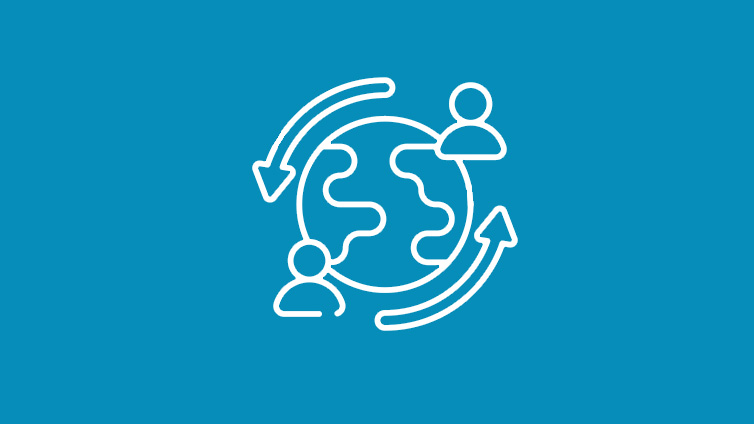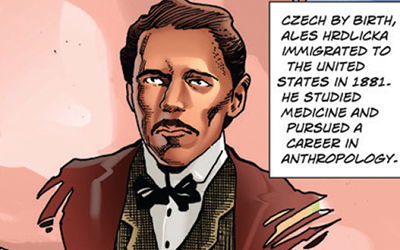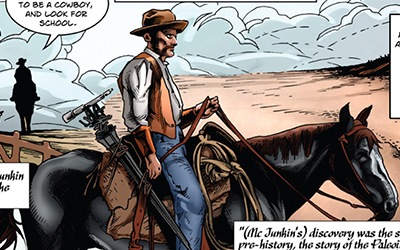Migration
Teacher Resources
Driving Question: Where and why did early humans migrate?
All humans evolved in Africa c. 250,000 years ago. How did our ancestors migrate and populate the entire world by c. 15,000 years ago without the use of cars, airplanes, and ships? The answer has a lot to do with collective learning.
Learning Objectives:
- Investigate where and why early humans migrated.
- Explain the distribution and migration of human populations across Earth’s surface.
Vocab Terms:
- climate
- collective learning
- Homo sapiens
- migration
- symbolic langauge
Opener: Migration
To teach this lesson step, refer to page 2 of the Lesson 4.4 Teaching Guide.
Want to activate student’s prior knowledge? Check out the our Openers and Closers Guide for more information.
In this course, you’ve already crossed unimaginable cosmic distances. But, from a human perspective, you’re about to start the greatest journey of all!
On the Move
To teach this lesson step, refer to page 2 of the Lesson 4.4 Teaching Guide.
Curious to know what other teachers are thinking about in terms of human migration? Check out this conversation in the OER Project Teacher Community.
Lots of people enjoy vacationing, but it would take a lot to get them to leave home permanently. This slideshow and activity ask why some humans left their original home in Africa long ago.
Human Movement and Migration
Impact of Geography
Want to explore how climate can impact migration today? Check out this video on the ways climate change is shaping human movement in OER Project: Climate.
Early humans are on the move. What would be on your list of desirable features in a new neighborhood? Use this geography activity and series of maps to figure out the push and pull factors.
Migration and Climate Maps
Closer: Migration
To teach this lesson step, refer to page 5 of the Lesson 4.4 Teaching Guide.
Want to dive into migration even more? Check out this OER Project blog post.
By the end of this unit, humans will have spread across the globe. Before we move on, let’s take one more close look at what caused this.
The Americas
To teach this lesson step, refer to page 5 of the Lesson 4.4 Teaching Guide.
It’s easy enough to trace how humans moved from Africa to, say, Western Asia. But how the heck did we get all the way to the Americas?
-
Guiding Questions
-
Before you read
Preview the questions below, and then skim the comic, paying attention to things like prominent colors, shapes, and types of text and fonts. How do you know where to start and in which direction to read? What’s in the gutters (the space between panels)? Who or what is the focus of the comic?
While you read
Look for answers to these questions:
- What was an important contribution that Ales Hrdlicka made to the field of anthropology?
- What did Hrdlicka believe to be the timeline of human history in the Americas?
- What evidence was discovered by archaeologists in Folsom, New Mexico, that challenged Hrdlicka’s timeline?
- In the center of the page, a large image of Hrdlicka is shown blocking a group of early humans moving from Asia toward the Americas. How does the artist use these images to contribute to your understanding of Hrdlicka’s complex legacy?
After you read
Respond to this question: What evidence does Ales Hrdlicka’s story provide about the way collective learning is built over time?
Key Ideas
-
Guiding Questions
-
Before you listen
Preview the questions below, and then review the transcript.
While you listen
Look for answers to these questions:
- How do we know that early humans migrated from northeastern Asia to the Americas?
- What prevented early humans from accessing the Americas?
- Why did the population of early humans in the Americas grow rapidly?
- When does Peter Bellwood think that early humans arrived in the Americas and what evidence is he using to determine this date?
After you listen
Respond to this question: Do you think it’s possible that early humans could have migrated to the Americas before the end of the last ice age? Explain your reasoning.
-
Guiding Questions
-
Before you read
Preview the questions below, and then skim the comic, paying attention to things like prominent colors, shapes, and types of text and fonts. How do you know where to start and in which direction to read? What’s in the gutters (the space between panels)? Who or what is the focus of the comic?
While you read
Look for answers to these questions:
- In the early twentieth century, what did most archaeologists believe regarding human history in the Americas?
- Why was George McJunkin’s discovery at the Folsom site important?
- The professional archaeologists who first came to the Folsom site years after McJunkin’s death never gave him credit for his role in the discovery. How then, decades later, was his contribution acknowledged?
- Throughout the graphic biography, McJunkin’s face is covered in shadow. Why do you think the artist chose to represent his image in that way?
After you read
Respond to this question: How does George McJunkin’s story challenge what you have learned about collective learning and the way stories and knowledge are passed through generations?

































